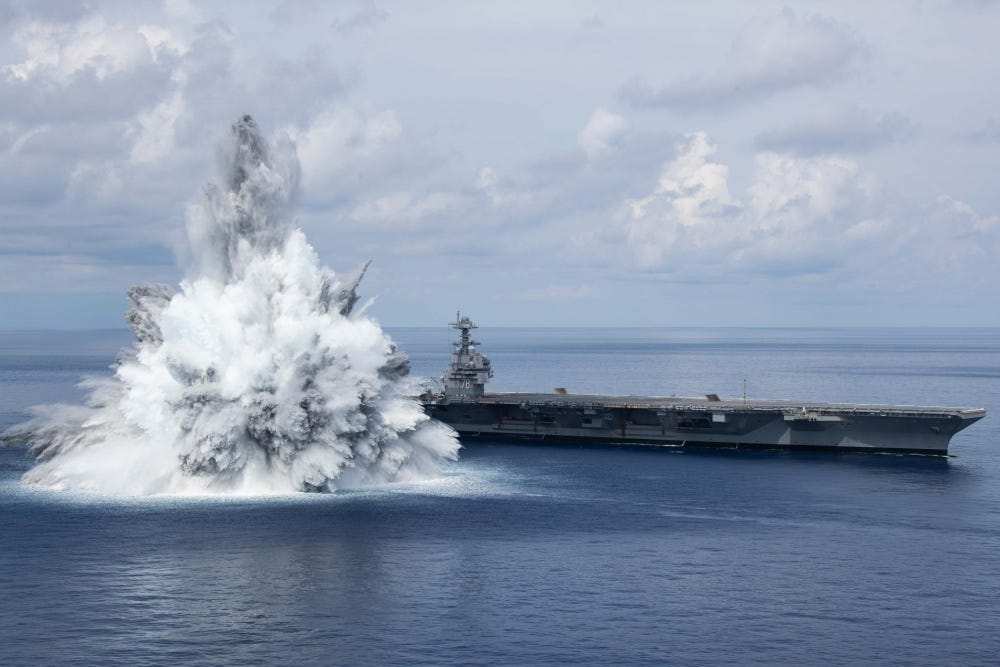The massive plume of ocean water flew higher than the 250-foot-tall mast of the U.S. Navy’s newest aircraft carrier on Sunday off Jacksonville, the explosion blasting a circle of white-capped waves that briefly matched the leviathan’s 1,092-foot length.
When the shockwave and rumble of the planned underwater blast subsided, the Navy said the nuclear aircraft carrier USS Gerald R. Ford had completed the third and last blast in its Full Ship Shock Trials.
“The Navy designed the Ford-class carrier using advanced computer modeling methods, testing, and analysis to ensure the ships are hardened to withstand harsh battle conditions,” said Capt. Brian Metcalf, the Navy’s future aircraft carrier program manager. “These shock trials have tested the resiliency of Ford and her crew and provided extensive data used in the process of validating the shock hardness of the ship.”
The Ford is the newest aircraft carrier in the U.S. Navy, representing the first major redesign since the 1960s. Commissioned four years ago, the aircraft carrier will eventually be home to about 4,500 crewmembers and 75 aircraft and capable of 30 knots-plus from its dual nuclear reactors, the Navy said. It was built to honor the 38th President of the United States.

(Dan Scanlan/ The Florida Times-Union/TNS)
Shock trials are designed to validate a ship’s ability to sustain operations in a simulated combat environment using live ordnance. During its four-month testing evolution, the Ford withstood the impact of three 40,000-pound underwater blasts that were released at distances progressively closer to the ship.
The goal of the tests is also to ensure that the carrier’s combat systems will perform as designed in combat, Metcalf said, adding that tests done Sunday and prior to that “proved to the crew, fairly dramatically” that the ship will be able to withstand formidable shocks and continue to operate under extreme conditions.
Prior to each explosion, the Navy team notified boaters and commercial ships to avoid the test area, with protocols to ensure the safety of military and civilians participating in the operation.
Capt. Paul Lanzilotta, the carrier’s commanding officer, approved the explosion after determining ship and crew readiness, weather and surface conditions as well as environmental mitigation measures, designed to protect any marine life spotted within the test area.
More than a dozen scientists, biologists and observers were assigned to the Ford, nearby support vessels and observation aircraft. Observers used high-powered lenses to detect if marine life was nearby prior to the explosions, the Navy said.
The first two explosive tests occurred on June 18 and July 16.
The ship and crew performed very well during the tests, said Rear Adm. James Downey, program executive officer for aircraft carriers.
“We’re designing and building these aircraft carriers to sail in some of the world’s most contested security environments,” he said. “So when you think about the threats to warships posed by non-contact blasts and the number of sea mines in the inventories of navies around the world, the gravity and consequence of these shock trials really come into focus.”
The Gerald R. Ford is returning to the Tidewater area in Maryland for a 6-month detailed inspection to assess any damage sustained during the test explosions and to continue work in advance of the ship’s deployment next year.
___
© 2021 www.jacksonville.com
Distributed by Tribune Content Agency, LLC.



